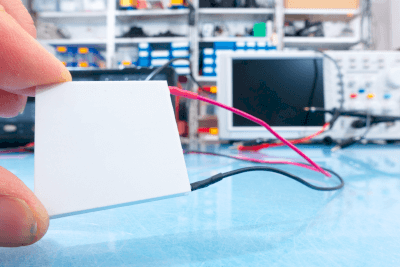What Is a Peltier Module?

A Peltier module is a device that utilizes the thermoelectric effect to interchange heat and electricity.
It transfers heat in one direction using the Peltier effect, discovered by French physicist Jean-Charles Assayul Peltier in the 19th century. This effect occurs when electrical current flows between different types of conductors, causing heat transfer. Peltier modules typically consist of numerous elements made from ceramic or semiconductor materials.
Due to their compact size and efficient control performance, Peltier modules are widely used in the cooling and thermal management of electronic devices. They operate without mechanical parts, thus reducing noise and eliminating wear and tear. However, they have limitations in efficiency and are sometimes less effective than other cooling and heating technologies.
Uses of Peltier Modules
Peltier modules have a range of applications:
1. Cooling of Electronic Equipment
These modules are instrumental in dissipating heat from electronic equipment, such as CPUs and graphics cards in computers. They attach directly to these components, reducing their operating temperature and enhancing performance stability and reliability.
2. Refrigerators and Cooling Devices
Peltier modules are also found in some compact refrigerators and cooling units, valued for their small size, quiet operation, and portability. They are common in personal-use coolers and hotel room refrigerators. For larger capacity or higher efficiency cooling, other types of chillers are often more suitable.
3. Cooling of Optical Equipment
In optical devices such as telescopes and lenses, Peltier modules help maintain stable optical characteristics by minimizing temperature-induced changes. They are also used to prevent overheating in semiconductor lasers and similar devices.
Principle of Peltier Modules
Peltier Modules operate based on the thermoelectric effect. This phenomenon involves heat transfer when electrical current flows through different types of conductors. The module consists of P-type and N-type semiconductors and metal, bonded between two metal plates. The flow of current from N-type to P-type semiconductors causes one junction to cool and the other to heat.
The Seebeck effect, or reverse Peltier phenomenon, occurs when a temperature difference is applied to a Peltier module, generating voltage. This principle is utilized in thermocouple thermometers.
How to Select a Peltier Module
Consider these factors when selecting a Peltier module:
1. Operating Voltage
Choose a module with an operating voltage compatible with your power supply and control system. Most low-voltage Peltier modules operate at 30 V or lower.
2. Generated Temperature Difference and Heat Absorption
Select a module based on the required cooling or heating capacity, considering its temperature difference generation and heat absorption capabilities.
3. Dimensions and Shape
Consider the intended environment and equipment constraints. Modules should fit the space and shape of the installation site. If specific dimensions or shapes are required, choose accordingly.